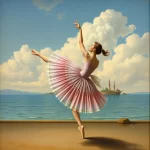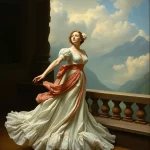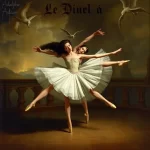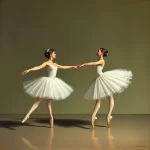Ballet: L’Île Enchantée (Arthur Sullivan, 1864)

Introduction
Ballet: L’Île Enchantée is a one-act ballet composed by Arthur Sullivan in 1864. The ballet was choreographed by H. Desplaces and premiered at the Royal Italian Opera House in Covent Garden, London. The ballet’s plot revolves around a magical island where love and enchantment intertwine, creating a captivating narrative that has enchanted audiences since its debut.
Historical Background
Creation and Development
The mid-19th century was a period of significant transformation in the arts, marked by the Romantic movement’s emphasis on emotion, nature, and individualism. L’Île Enchantée was created within this context, drawing inspiration from the era’s fascination with fairy tales and fantastical themes. The ballet’s storyline is believed to be influenced by various literary sources and folklore, which were popular at the time.
Arthur Sullivan, who would later gain fame for his collaborations with W.S. Gilbert, was a young composer when he wrote the score for L’Île Enchantée. His collaboration with choreographer H. Desplaces and other key figures in the production was crucial in bringing the ballet to life. The synergy between Sullivan’s music and Desplaces’ choreography resulted in a seamless blend of narrative and dance.
Premiere and Reception
L’Île Enchantée premiered on May 16, 1864, at the Royal Italian Opera House in Covent Garden, London. The initial reception was positive, with critics and audiences praising the ballet’s enchanting music and innovative choreography. The ballet’s success led to several notable early performances and revivals, solidifying its place in the repertoire of 19th-century ballet.
Synopsis of the Ballet
L’Île Enchantée is a one-act ballet that unfolds on a magical island. The narrative is driven by themes of love, enchantment, and transformation, creating a captivating and whimsical story.
Detailed Summary
The ballet opens with a shipwreck, leaving a group of sailors stranded on a mysterious island. As they explore their surroundings, they encounter various magical creatures, including nymphs and fairies. The island is ruled by a powerful enchantress who has the ability to control the elements and manipulate the fate of those who land on her shores.
Among the shipwrecked sailors is a young man who falls in love with one of the island’s nymphs. Their love story becomes the central focus of the ballet, as they navigate the challenges posed by the enchantress and her magical powers. Key moments in the ballet include the sailors’ initial discovery of the island, the young man’s encounter with the nymph, and the enchantress’s attempts to thwart their love.
Finale
The ballet concludes with a dramatic resolution, as the young man’s love for the nymph ultimately breaks the enchantress’s spell. The island is transformed from a place of danger and enchantment to one of peace and harmony. The finale celebrates the triumph of love and the power of human connection, leaving the audience with a sense of wonder and enchantment.
Musical Composition
Composer’s Role
Arthur Sullivan, best known for his later work with W.S. Gilbert, was a young and relatively unknown composer when he wrote the score for L’Île Enchantée. His contribution to the ballet was significant, as his music provided the emotional and narrative foundation for the choreography. Sullivan’s score is characterized by its lyrical melodies, rich harmonies, and evocative orchestration, which enhance the ballet’s magical and romantic themes.
Musical Themes and Motifs
The score of L’Île Enchantée features several recurring musical themes and leitmotifs that represent different characters and emotions. For example, the enchantress’s theme is characterized by mysterious and dissonant harmonies, while the love theme between the young man and the nymph is marked by lyrical and flowing melodies. These musical motifs help to reinforce the narrative and emotional arc of the ballet, creating a cohesive and immersive experience for the audience.
Famous Recordings and Performances
While L’Île Enchantée is not as widely recorded as some of Sullivan’s later works, there are several notable recordings and performances of the ballet’s music. These recordings capture the beauty and intricacy of Sullivan’s score, allowing modern audiences to appreciate the composer’s early work. Some of the most iconic performances of the ballet’s music have been conducted by renowned conductors and performed by leading orchestras, showcasing the enduring appeal of Sullivan’s composition.
Choreography and Dance
Choreographer’s Vision
H. Desplaces, the choreographer of L’Île Enchantée, brought a unique vision to the ballet. His interpretation emphasized the magical and fantastical elements of the story, using innovative choreography to bring the island’s enchantment to life. Desplaces’ style was characterized by fluid and expressive movements, which complemented Sullivan’s lyrical music and enhanced the narrative’s emotional depth.
Signature Dance Numbers
One of the key dance numbers in L’Île Enchantée is the Pas de Deux between the young man and the nymph. This dance is a highlight of the ballet, showcasing the chemistry and connection between the two characters. The choreography reflects their love story, with graceful lifts and intricate partnering that convey their emotional bond. Other notable dance numbers include the sailors’ initial exploration of the island and the enchantress’s solo, which highlights her power and mystique.
Notable Interpretations
Over the years, different productions of L’Île Enchantée have interpreted and adapted the choreography in various ways. Some productions have emphasized the ballet’s romantic elements, while others have focused on its magical and fantastical aspects. These interpretations have allowed the ballet to remain fresh and relevant, appealing to new generations of audiences and dancers.
Characters and Roles
Main Characters
- The Young Man: A shipwrecked sailor who falls in love with a nymph on the enchanted island. His character is marked by bravery, determination, and a deep sense of love.
- The Nymph: A magical creature who lives on the island and becomes the object of the young man’s affection. She is characterized by her grace, beauty, and connection to nature.
- The Enchantress: The ruler of the island, who possesses powerful magical abilities. She is a complex character, both alluring and menacing, and serves as the primary antagonist in the ballet.
Supporting Characters
- The Sailors: The young man’s companions who are also shipwrecked on the island. They provide comic relief and support the main narrative.
- The Fairies and Nymphs: Magical creatures who inhabit the island and interact with the main characters. They add to the ballet’s enchanting atmosphere and participate in various dance numbers.
Famous Dancers
Over the years, several notable dancers have portrayed the lead roles in L’Île Enchantée. These include renowned ballerinas and danseurs who have brought their unique interpretations to the characters, adding to the ballet’s rich performance history.
Cultural and Artistic Impact
Influence on Ballet and Dance
L’Île Enchantée has had a lasting impact on the world of ballet and dance. Its innovative choreography and enchanting music have influenced other works and choreographers, contributing to the development of ballet as an art form. The ballet’s emphasis on narrative and emotion has also helped to shape the storytelling techniques used in later ballets.
Cultural Significance
The ballet’s themes of love, enchantment, and transformation have resonated with audiences and inspired adaptations in various media. L’Île Enchantée has been referenced in literature, theater, and even film, highlighting its enduring cultural significance. The ballet’s magical and fantastical elements continue to captivate audiences, making it a beloved work in the ballet repertoire.
Legacy and Revivals
L’Île Enchantée has seen several major revivals and reinterpretations over the years. These productions have brought new life to the ballet, showcasing its timeless appeal and relevance. Modern adaptations have incorporated contemporary choreography and design elements, while still honoring the original work’s spirit and vision. The ballet continues to be performed and celebrated today, ensuring its legacy for future generations.
Iconic Productions
Historic Productions
Some of the most famous historical productions of L’Île Enchantée include its original premiere at the Royal Italian Opera House and subsequent performances at major theaters around the world. These productions featured key figures such as renowned dancers, directors, and set designers who contributed to the ballet’s success and enduring popularity.
Contemporary Productions
Recent productions of L’Île Enchantée have brought fresh interpretations to the ballet, incorporating modern choreography and design elements. These contemporary productions have been praised for their innovative approaches while still honoring the original work’s essence. They have introduced the ballet to new audiences and ensured its continued relevance in the world of dance.
Production Design
The set, costume, and lighting design in various productions of L’Île Enchantée have played a crucial role in bringing the magical island to life. From elaborate sets that depict the island’s enchanting landscapes to intricate costumes that reflect the characters’ personalities, the production design has enhanced the ballet’s visual and emotional impact. Lighting design has also been used to create mood and atmosphere, adding to the overall enchantment of the performance.
Critical Reception and Reviews
Initial Critical Response
At the time of its premiere, L’Île Enchantée received positive reviews from critics who praised its enchanting music, innovative choreography, and captivating narrative. The ballet was lauded for its ability to transport audiences to a magical world, and its success led to several notable early performances and revivals.
Modern Reviews
Contemporary critics and audiences continue to appreciate L’Île Enchantée for its timeless appeal and artistic merit. Modern reviews often highlight the ballet’s beautiful music, expressive choreography, and engaging story. The ballet’s ability to resonate with audiences across generations is a testament to its enduring relevance and popularity.
Fun Facts and Trivia
Behind-the-Scenes Stories
One interesting anecdote from the production of L’Île Enchantée involves a last-minute change to the choreography due to an injury sustained by one of the lead dancers. The choreographer had to quickly adapt the dance numbers to accommodate the injured dancer, resulting in some of the ballet’s most memorable moments.
Notable Performers
Several famous dancers, conductors, and directors have been associated with L’Île Enchantée over the years. These include renowned ballerinas who have brought their unique interpretations to the lead roles, as well as conductors who have brought Sullivan’s music to life with their expert direction.
Trivia
- Arthur Sullivan: L’Île Enchantée was one of Sullivan’s early works, composed before his famous collaborations with W.S. Gilbert.
- Magical Elements: The ballet’s use of magical and fantastical themes was influenced by the Romantic movement’s fascination with fairy tales and folklore.
- Innovative Choreography: H. Desplaces’ choreography for L’Île Enchantée was considered innovative for its time, incorporating fluid and expressive movements that enhanced the narrative.
Conclusion
Summary of the Ballet’s Importance
L’Île Enchantée is a significant work in the world of ballet, known for its enchanting music, innovative choreography, and captivating narrative. The ballet’s themes of love, enchantment, and transformation have resonated with audiences for over a century, making it a beloved work in the ballet repertoire.
Final Thoughts
L’Île Enchantée continues to captivate audiences with its magical story and beautiful music. Its enduring appeal is a testament to the artistic vision of Arthur Sullivan and H. Desplaces, as well as the many performers who have brought the ballet to life over the years. Whether you are a seasoned ballet enthusiast or a newcomer to the art form, L’Île Enchantée is a must-see performance that will transport you to a world of enchantment and wonder.
FAQ
What is the central theme of this ballet?
The central theme of L’Île Enchantée is the power of love and enchantment, set against the backdrop of a magical island.
Who are the main characters in this ballet?
The main characters include the young man (a shipwrecked sailor), the nymph (a magical creature), and the enchantress (the ruler of the island).
What is the most famous dance number in this ballet?
The Pas de Deux between the young man and the nymph is one of the most famous dance numbers in L’Île Enchantée, showcasing their love story through graceful and expressive choreography.
How long does a typical performance of this ballet last?
A typical performance of L’Île Enchantée lasts approximately 45 minutes to an hour, as it is a one-act ballet.
Are there any modern adaptations of this ballet?
Yes, there have been several modern adaptations of L’Île Enchantée, incorporating contemporary choreography and design elements while still honoring the original work’s spirit and vision.
Why is this ballet considered important in the history of dance?
L’Île Enchantée is considered important in the history of dance for its innovative choreography, enchanting music, and captivating narrative. It has influenced other works and choreographers, contributing to the development of ballet as an art form.





